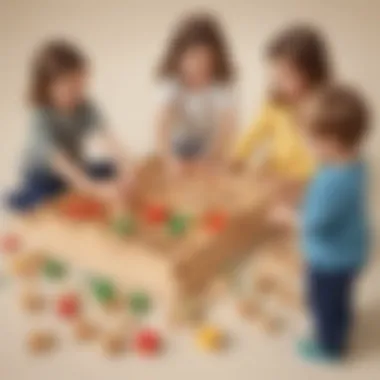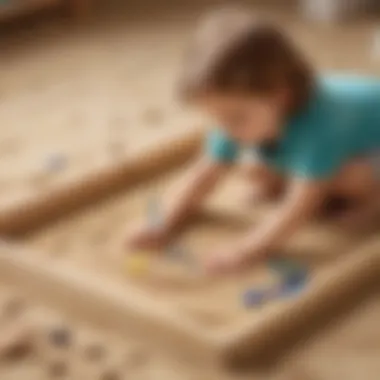Crafting Exceptional Kindergarten Letter Recognition Lesson Plans


Interactive Learning Games
As kindergarten is a crucial time for children to develop foundational skills like letter recognition, interactive learning games play a pivotal role in engaging young learners. Popular games such as 'Alphabet Bingo' and 'Letter Matching' are designed to make the learning process enjoyable and effective. These games provide children with hands-on experience in identifying and associating letters, fostering cognitive development. Educational games not only entertain children but also offer tangible benefits for their cognitive growth. By engaging in these activities, kids can enhance their memory, problem-solving abilities, and language skills. Game reviews offer valuable insights into the efficacy of selected educational games, comparing gameplay mechanics and learning outcomes to help parents and educators make informed choices.
Introduction
Letter recognition is a foundational skill essential for the early literacy development of kindergarten students. This section delves into the crucial role that effective letter recognition lesson plans play in nurturing young learners' literacy abilities. By immersing children in engaging activities and tailored strategies, educators and caregivers lay the groundwork for future reading and writing proficiency. Through thoughtful planning and execution of these lesson plans, children not only learn to identify letters but also develop a strong foundation for language acquisition and communication.
Importance of Letter Recognition
A fundamental aspect of early childhood education, letter recognition sets the stage for successful literacy acquisition. Understanding the importance of letter recognition in kindergarten is paramount as it establishes the connection between letters and sounds, a fundamental skill for reading and writing. These lesson plans focus on breaking down the complexities of written language into manageable units for young learners. By engaging children in activities that promote letter recognition, educators facilitate a smooth transition into more advanced literacy skills. The ability to recognize letters not only aids in reading fluency but also enhances overall cognitive development in young learners.
Understanding Kindergarten Learners
Understanding Kindergarten learners is pivotal in creating effective letter recognition lesson plans. Kindergarteners are at a crucial stage of development where they are honing their cognitive skills, language abilities, and social interactions. By comprehending the needs and characteristics of these young learners, educators and caregivers can tailor lesson plans that align with their developmental stage and promote optimal learning outcomes. Understanding the cognitive development and learning styles of Kindergarten children is imperative to design engaging and meaningful activities that cater to their individual needs and preferences.
Cognitive Development at Kindergarten Age
At the age of Kindergarten, typically between 4 to 6 years old, children undergo significant cognitive growth. This period is characterized by rapid brain development, memory enhancement, and the acquisition of language skills. Kindergarteners begin to demonstrate logical reasoning, problem-solving abilities, and the capacity to understand complex instructions. Designing letter recognition lesson plans that align with their cognitive abilities fosters intellectual stimulation and encourages a deeper understanding of language structure and phonetics.


Learning Styles and Preferences
Kindergarten children exhibit diverse learning styles and preferences, including visual, auditory, kinesthetic, and tactile modalities. Some children may learn best through visual aids like colorful visuals and charts, while others thrive in hands-on experiences such as interactive games and manipulatives. Recognizing and catering to these varied learning styles ensures that lesson plans are engaging, inclusive, and effective for all students. By incorporating a mix of sensory activities, multimedia resources, and interactive tools, educators can create a dynamic learning environment that resonates with each child's unique learning preferences and optimizes their letter recognition skills.
Designing Letter Recognition Lesson Plans
In the realm of effective education for kindergarteners, designing letter recognition lesson plans stands as a pivotal element. It serves as the bedrock upon which a child's understanding of language and literacy is built. Designing these plans involves a meticulous consideration of various factors to ensure young learners grasp the intricacies of letters effectively. By structuring engaging lesson plans, educators can foster a strong foundation for language development.
Setting Clear Learning Objectives
Setting clear learning objectives within letter recognition lesson plans is paramount for guiding educational journeys effectively. These objectives act as signposts, directing both educators and students towards the desired destination of enhanced letter recognition. Clarity in objectives enables educators to tailor their teaching methods to align with specific goals, ensuring that learning remains focused and purposeful.
Incorporating Multisensory Activities
The integration of multisensory activities into letter recognition lesson plans enhances the educational experience for kindergarteners. By engaging multiple senses in the learning process, such as touch, sight, and hearing, children can deepen their understanding of letters in a holistic manner. This approach not only caters to diverse learning styles but also reinforces letter recognition through experiential learning, making the educational journey enjoyable and effective.
Utilizing Technology and Interactive Tools
Leveraging technology and interactive tools in crafting letter recognition lesson plans can revolutionize the learning experience for young learners. Interactive applications, educational software, and digital resources provide dynamic ways to engage children with letters, making the learning process more interactive and stimulating. By incorporating technology, educators can enhance letter recognition activities, catering to the digital-native generation and fostering a technologically adept learning environment.


Engaging Letter Recognition Activities
In the realm of early childhood education, engaging letter recognition activities play a pivotal role in fostering literacy skills among kindergarten students. These activities serve as a cornerstone in the development of children's foundational knowledge of letters, enabling them to transition smoothly into reading and writing. By incorporating interactive and captivating experiences into the learning process, educators can create an enriching environment that sparkles with enthusiasm and curiosity. The significance of engaging letter recognition activities lies in their ability to not only educate but also to captivate young learners, making the journey of acquiring literacy skills a delightful adventure.
Alphabet Sensory Bins
Alphabet sensory bins are a creative and tactile approach to letter recognition that stimulates multiple senses simultaneously in young learners. These bins are filled with various materials like rice, sand, or even small toys, each representing a different letter of the alphabet. Children immerse themselves in these sensory materials, exploring the shapes and forms of letters through touch and visual cues. This hands-on experience helps reinforce letter recognition in a playful and interactive manner, making learning engaging and memorable for kindergarten students. Educators can customize sensory bins to suit the diverse learning styles and preferences of their students, ensuring an inclusive and effective letter recognition learning environment.
Letter Hunt Games
Letter hunt games are dynamic and exciting activities that elevate the process of letter recognition into a thrilling adventure. Through scavenger hunts, interactive games, or outdoor exploration, children embark on quests to find and identify specific letters in their surroundings. This gamified approach not only enhances letter recognition skills but also promotes cognitive development and problem-solving abilities in young learners. Letter hunt games infuse an element of fun and challenge into the learning experience, encouraging active participation and fostering a positive attitude towards literacy acquisition.
Letter Crafts and Art Projects
Letter crafts and art projects serve as creative outlets for kindergarten students to express their imagination while reinforcing letter recognition skills. By engaging in hands-on activities like collages, painting, or sculpting, children transform abstract letters into tangible and visually appealing creations. These art projects not only enhance fine motor skills but also deepen children's understanding and memory of letters through artistic exploration. Letter crafts allow for individual expression and creativity, making the learning process unique and rewarding for each student. Incorporating art into letter recognition lessons adds a layer of excitement and personalization, turning educational activities into moments of imaginative expression and growth.
Assessment and Progress Monitoring
Methods for Evaluating Letter Recognition


The methods for evaluating letter recognition skills among kindergarten students are diverse and insightful. One effective method is through informal assessments during daily activities, such as circle time or small group tasks. Observing how students interact with letters in various activities provides valuable insight into their recognition abilities. Another practical approach is using games and hands-on activities tailored to assess letter recognition skills. These interactive tools not only engage students but also provide tangible results for educators to gauge the level of letter recognition mastery. Furthermore, incorporating technology-based assessments, like educational apps or online quizzes, offers a dynamic way to evaluate letter recognition while catering to tech-savvy young learners. Overall, a combination of informal observations, interactive activities, and technology-based assessments ensures a comprehensive evaluation of kindergarten students' letter recognition proficiency.
Involving Families in Letter Recognition Activities
Within the context of letter recognition activities for kindergarten students, the involvement of families plays a pivotal role in enhancing the educational process. By extending learning beyond the classroom and into the home environment, educators can create a symbiotic relationship between school-based instruction and family-centered reinforcement strategies that amplify the acquisition of literacy skills among young learners.
Involving families in letter recognition activities transcends mere parental engagement; it cultivates a collaborative learning dynamic that empowers parents as educational partners in their child's academic journey. Through the integration of interactive and inclusive initiatives that promote family involvement, educators can bridge the gap between school and home, setting the stage for a harmonized approach to letter recognition instruction.
By encouraging families to participate in letter recognition activities, educators pave the way for a seamless integration of learning experiences across various facets of a child's life. This integration not only bolsters the comprehension and retention of letter-related concepts but also nurtures a sense of shared responsibility and achievement within the family unit. Through engaging and innovative activities that invite parental participation, educators can spark a collective enthusiasm for learning that reverberates through the child's academic progress.
Moreover, involving families in letter recognition activities serves to reinforce the importance of literacy within the household, creating a supportive ecosystem that values and prioritizes educational growth. By fostering a culture of learning that extends beyond traditional classroom boundaries, educators can cultivate a rich tapestry of educational experiences that enrich and empower both students and their families. In essence, the involvement of families in letter recognition activities bolsters the educational foundation of kindergarten learners, instilling a collaborative spirit that celebrates the beauty of shared learning and discovery.
Conclusion
Diving deeper into the critical aspects of the conclusion, one must consider the overarching impact of tailored lesson plans on kindergarten students' letter recognition abilities. Through a meticulous analysis of cognitive development, learning styles, multisensory activities, and technological integration highlighted in this article, the conclusion serves as a catalyst for implementing innovative and engaging strategies in educational settings. Additionally, the conclusion acts as a compass for assessing student progress, fostering collaboration with parents, and amplifying the overall efficacy of letter recognition instruction.
Furthermore, the conclusion serves as a beacon of guidance for educators seeking to optimize the learning experience of young learners. By synthesizing and distilling key insights, strategies, and activities elucidated in the previous sections, this conclusion cements the importance of investing time and effort in creating tailored lesson plans that not only enhance letter recognition but also ignite a passion for learning in kindergarten students. In essence, the conclusion encapsulates the essence of effective letter recognition instruction, paving the way for a transformative educational journey for both educators and students.
Emphasizing the Impact of Effective Letter Recognition Instruction
As we unravel the layers of effective letter recognition instruction tailored for kindergarten learners, it becomes paramount to underscore the profound impact such strategies wield on children's cognitive development and literacy skills. The significance of this aspect lies in its ability to lay a sturdy foundation for future academic pursuits by nurturing a strong grasp of letter recognition in young minds.
Delving into the core of the impact, it is crucial to highlight how well-structured lesson plans fuel children's cognitive growth at a pivotal stage of their learning journey. By engaging students in multisensory activities, promoting interactive learning experiences, and harnessing the power of technology, effective letter recognition instruction cultivates a rich learning environment where children thrive and develop essential literacy skills.
Moreover, the impact of tailored instruction extends beyond the classroom, influencing parents and caregivers to actively participate in fostering a conducive learning atmosphere for young learners. By emphasizing the practical application of letter recognition skills in daily activities and encouraging family involvement, educators can forge a strong bond between home and school, amplifying the impact of instruction and fostering a holistic approach to early childhood education.
In essence, emphasizing the impact of effective letter recognition instruction illuminates the transformative potential of tailored lesson plans in shaping the educational journey of kindergarten students. By integrating innovative strategies and fostering collaborative partnerships, educators pave the way for a seamless learning experience that not only enhances letter recognition skills but also nurtures a lifelong love for learning in young minds.















